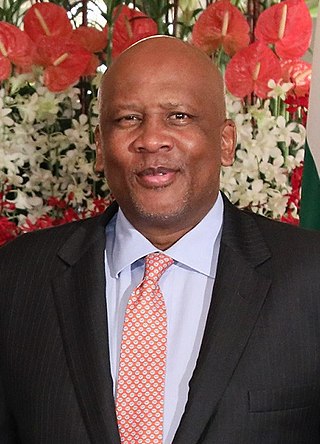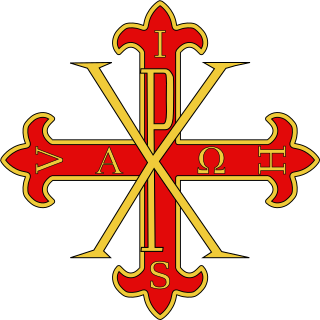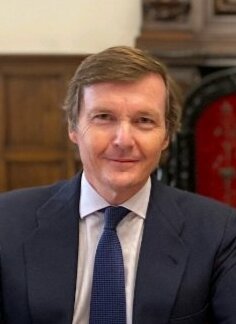External links
- Gilles Constantinian profile Archived 2008-11-15 at the Wayback Machine at chamoisfc79.fr
| Personal information | |||
|---|---|---|---|
| Full name | Gilles Constantinian | ||
| Date of birth | October 27, 1964 | ||
| Place of birth | Lyon, France | ||
| Height | 1.84 m (6 ft 1⁄2 in) | ||
| Position(s) | Striker | ||
| Senior career* | |||
| Years | Team | Apps | (Gls) |
| 1982–1987 | Lyon | 4 | (0) |
| 1987–1990 | Gueugnon | 88 | (17) |
| 1990–1991 | Chamois Niortais | 33 | (9) |
| 1991–1993 | Créteil | 44 | (13) |
| 1993–1996 | Grenoble | 77 | (30) |
| 1996–1997 | Nîmes | 9 | (2) |
| 1997–1998 | Besançon | 13 | (5) |
| 1998–1999 | FC Vaulx-en-Velin | 25 | (5) |
| *Club domestic league appearances and goals | |||
Gilles Constantinian (born October 27, 1964) is a former professional footballer. He played as a centre forward.

Nicholas Joseph Orville Liverpool was a politician and jurist from Dominica who served as the sixth President of Dominica from 2 October 2003 to 17 September 2012.

Letsie III is King of Lesotho. He succeeded his father, Bereng Seeiso Moshoeshoe II, who was forced into exile in 1990. His father was briefly restored in 1995 but died in a car crash in early 1996, and Letsie became king again. As a constitutional monarch, most of King Letsie's duties as monarch of Lesotho are ceremonial. In 2000, he declared HIV/AIDS in Lesotho to be a natural disaster, prompting immediate national and international response to the epidemic.

Abdul Qadir Bajamal was a Yemeni politician who served as Prime Minister from 31 March 2001 to 7 April 2007. He was a member of the General People's Congress party and was appointed as Prime Minister by President Ali Abdullah Saleh. Previously he served as Foreign Minister from 1998 to 2001, and Deputy Prime Minister of Yemen from 1994 to 2001.

The Constantinian shift was, according to some theologians and historians of antiquity, a set of political and theological changes that took place during the 4th-century under the leadership of Emperor Constantine the Great. Rodney Clapp claims that the shift or change started in the year 200. The term was popularized by the Mennonite theologian John H. Yoder. He claims that the change was not just freedom from persecution but an alliance between the State and the Church that led to a kind of Caesaropapism. The claim that there ever was a Constantinian shift has been disputed; Peter Leithart argues that there was a "brief, ambiguous 'Constantinian moment' in the fourth century", but that there was "no permanent, epochal 'Constantinian shift'".

Princess Elena of Romania is the second eldest daughter of King Michael I and Queen Anne of Romania.

During the reign of the Roman emperor Constantine the Great (306–337 AD), Christianity began to transition to the dominant religion of the Roman Empire. Historians remain uncertain about Constantine's reasons for favoring Christianity, and theologians and historians have often argued about which form of early Christianity he subscribed to. There is no consensus among scholars as to whether he adopted his mother Helena's Christianity in his youth, or, as claimed by Eusebius of Caesarea, encouraged her to convert to the faith he had adopted.

The Illustrious Royal Order of Saint Januarius is a Roman Catholic order of knighthood founded by Charles VII of Naples in 1738. It was the last great dynastic order to be constituted as a chivalric fraternity, with a limitation to Roman Catholics and a direct attachment to the dynasty rather than the state. The founder of the order, Charles VII of Naples, ruled from 1734 until 1759.

The Constantinian dynasty is an informal name for the ruling family of the Roman Empire from Constantius Chlorus to the death of Julian in 363. It is named after its most famous member, Constantine the Great, who became the sole ruler of the empire in 324. The dynasty is also called Neo-Flavian because every Constantinian emperor bore the name Flavius, similarly to the rulers of the first Flavian dynasty in the 1st century.
Jean-Christophe, Prince Napoléon, Prince of Montfort is a French businessman and the disputed head of the Imperial House of France, and as such the heir of Napoleon Bonaparte, the first Emperor of the French. He would be known as Napoleon VII.

Constantinianism is a religiopolitical ideology in Christian politics that epitomizes the unity of church and state, as opposed to separation of church and state. This view is modeled after an ideal Christendom, which arose during the reign of Constantine the Great.

The Sacred Military Constantinian Order of Saint George, also historically referred to as the Imperial Constantinian Order of Saint George and the Order of the Constantinian Angelic Knights of Saint George, is a dynastic order of knighthood of the House of Bourbon-Two Sicilies. Currently, the grand magistry of the order is disputed among the two claimants to the headship of the formerly reigning House of Bourbon-Two Sicilies as heirs of the House of Farnese, namely Prince Pedro and Prince Carlo. The order was one of the rare orders confirmed as a religious-military order in the papal bull Militantis Ecclesiae in 1718, owing to a notable success in liberating Christians in the Peloponnese. Together with the Sovereign Military Order of Malta, it is one of a small number of Catholic orders that still have this status today. It is not an order of chivalry under the patronage of the Holy See, but its membership is restricted to practising Catholics.

Prince Carlo of Bourbon-Two Sicilies, Duke of Castro is one of the two claimants to the headship of the House of Bourbon-Two Sicilies.

Princess Anne of Bourbon-Two Sicilies, Dowager Duchess of Calabria, born Princess Anne of Orléans, is the widow of Infante Carlos, Duke of Calabria. She is the third daughter and fifth child of Henri, Count of Paris, Orléanist claimant to the defunct French throne, and his wife Princess Isabelle of Orléans-Braganza.

Prince Pedro of Bourbon-Two Sicilies, Duke of Calabria, Grandee of Spain, is the only son of Infante Carlos, Duke of Calabria (1938–2015), and his wife, Princess Anne of Orléans. As primogeniture heir of the kings of the Two Sicilies he is the principal claimant to the headship of the Royal House of Bourbon-Two Sicilies, which ruled the Kingdom of the Two Sicilies before the unification of Italy.

Princess Béatrice Marie Caroline Louise Françoise of Bourbon-Two Sicilies is the eldest daughter of Prince Ferdinand, Duke of Castro, Castro-line claimant to the headship of the House of Bourbon-Two Sicilies, and his wife, Chantal de Chevron-Villette.
John of Antioch was a 7th-century chronicler, who wrote in Greek. He was a monk, apparently contemporary with Emperor Heraclius. Heinrich Gelzer identifies the author with the Monophysite Syrian Orthodox Patriarch of Antioch John of the Sedre, who ruled from 630 to 648.

Siaosi (George) Manumataongo ʻAlaivahamamaʻo ʻAhoʻeitu Konstantin Tukuʻaho is the crown prince of Tonga. Tupoutoʻa ʻUlukalala became heir apparent to the throne in March 2012 upon the accession of his father, Tupou VI, as King of Tonga.

In numismatics, the term Constantinian bronzes denotes the series of bronze coins issued in the Roman Empire in the middle of the 4th century. The specific denominations are unclear and debated by historians and numismatists. They are referred to as AE1, AE2, AE3, and AE4, with the former being the largest and the latter the smallest in diameter:
Andrea Angeli was the Grand Master of the Constantinian Order of Saint George from c. 1545 to 1580. Andrea and his brother Paolo were the founders of the Sacred Military Constantinian Order of Saint George and were papally recognized claimants to descent from the Angelos dynasty of Byzantine emperors. Andrea claimed the title "Duke and Count of Drivasto and Durazzo", and from the death of Arianitto Arianiti in 1551, also claimed the title "Prince of Macedonia".
Girolamo I Angeli was a joint, or rival, Grand Master of the Constantinian Order of Saint George from 1570 to 1591, together with, or against, his brother Andrea and then his nephew Pietro. Girolamo's family, the Angelo Flavio Comneno, claimed descent from the Angelos dynasty of Byzantine emperors, and Girolamo also claimed the title "Prince of Thessaly".